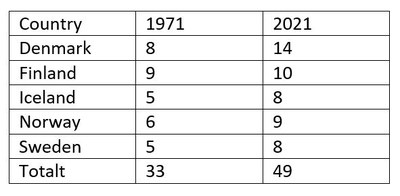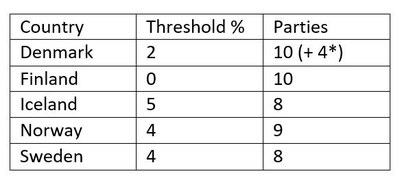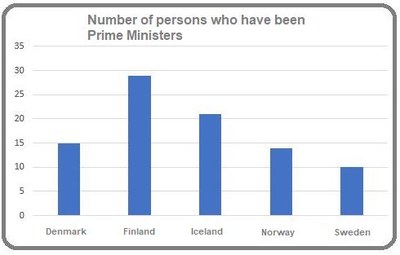Has it become harder to govern the Nordics?
Three of the five Nordic countries are now run by minority governments. Does this mean the political pillar of the Nordic model has grown weaker? While the power of the major established parties is dwindling across the Nordics, trade unions and employers gather in ever-larger organisations.
2021 is already a year of major political change in the Nordic region. And more change is afoot:
- In Sweden, Stefan Löfven’s government was toppled on 28 June. On 9 July, by the skin of his teeth, he managed to return to power with the same minority coalition comprising the Social Democrats and the Green Party. Only a few weeks later, however, Löfven announced he would step down in November as both Prime Minister and party leader for the Social Democrats.
- In Norway, parliamentary elections are being held on 13 September. Opinion polls show the country might end up with a red-green government made up of the Labour Party and the Centre Party. In all probability, this would be a minority government needing the support of several smaller parties. The most important of these is the Socialist Left, with who the Centre Party do not want to be in government. Support might also be needed from the even more radical Red Party or Green Party.
- In Iceland, parliamentary elections are being held on 25 September. The only possible majority coalition solution would be if the Conservative Independence Party agrees to continue its cooperation with the Left-Green Movement of current Prime Minister Katrín Jakobsdóttir.
General elections were also held in Greenland on 6 April, municipal elections in Finland on 13 June and on 16 November there will be municipal elections in Denmark – the only Nordic country that can call new parliamentary elections at any time but where municipal elections are held every four years.
More and more parties
If we disregard party politics and instead look at how the political systems work, there are certain trends that are found in all of the Nordic countries. Things do not happen rapidly, but if we look at it over a 50 year period the number of political parties in Nordic parliaments has risen from 33 in 1971 to 49 today:

For the social partners, the opposite is true. The number of trade unions has fallen as various unions have merged into ever-larger units. Denmark is at the forefront here, where LO merged with the white-collar union FTF on 1 January 2019. The new confederation is made up of 64 different trade unions representing 1.3 million members.
In Sweden, there are still three separate central organisations for workers – LO, the Confederation of Professional Employees TCO and the Confederation of Professional Associations SACO.
TCO and SACO along with the independent trade union Ledarna (representing private sector workers) are all members of the council for negotiation and cooperation PTK. At the end of 2019, PTK represented a total of 898,000 members in the private sector. That is a somewhat higher number than LO’s estimated 830,000 private sector members, according to Anders Kjellberg, Sweden’s leading expert in trade union organisation.
The older parties have in different ways tried to limit the possibilities for new parties to enter parliaments. The main tool has been to impose a threshold for how many votes a party needs in order to be included in the distribution of levelling seats.

*The number in brackets in Denmark represents the four places in the Danish parliament reserved for Greenland and the Faroe Islands. Right now these are occupied by four different parties, but these often have Danish sister parties which they usually vote with.
Finland does not have an election threshold because people vote for individual candidates and not parties. They also use a different mandate distribution model. Denmark’s record-high number of political parties is due to that country’s low electoral threshold. Several parties have emerged and disappeared over the years, more than those currently in parliament. The Netherlands is a country completely without electoral thresholds. As a result, there are currently 17 parties in parliament.
New parties can receive party support even if they have not reached the electoral threshold. In Sweden, for instance, party support is granted when a party gains 2.5% of votes.
So does a low electoral threshold mean more frequent changes of government? Not necessarily. If you look at how many prime ministers the Nordic countries. have had you get a somewhat different picture:

The graphs show how many prime ministers the countries have had as a result of post-WW2 elections. Finland tops the list with 29, while Sweden has had only ten.
In 1971, nearly all the Nordic countries had one large social democratic party and one more radical party to the left of this, one centre party representing farmers and fishermen, one conservative party and one liberal party. Today there is also one christian democratic party in all the countries except for Iceland. Sweden was the last country where such a party entered parliament, in 1991.
The new parliamentary parties are mainly green and populist parties (although the latter do not always agree with that label). The greens entered parliament in 1983 (Finland), 1991 (Sweden), 1994 (Denmark), 1999 (Iceland) and 2013 (Norway).
The populist parties began emerging in the early 1970s – first in Denmark was the Progress Party which entered parliament on 4 December 1973 with a landslide of 28 MPs. In Norway the party that would become the Progress Party was founded a little later, but gained four seats a bit earlier on 10 September 1973.
In Finnland, the Finns Party was founded in 1995. The New Democracy Party was represented in the Swedish parliament between 1991 and 1998, but split due to internal differences. The Sweden Democrats entered parliament in 2010.
Iceland is the last Nordic country to get a populist party, the People’s Party. They gained four seats in 2017, but split only two years later when two of their MPs were excluded from the party following a Reykjavik bar crawl where they had been caught mocking and criticising their party leader Inga Sæland.
In their book “The Battle Over Working-Class Voters (Routledge, 2021), Sanna Salo at the University of Helsinki and professor Jens Rydgren at Stockholm University have looked at the level of support populist parties in Denmark, Finland, Norway and Sweden get compared with the social democratic ones:
The red line represents the social democratic parties in each country and show how many percent of votes they have secured. The grey line represent what the authors classify as populist parties – the Danish People’s Party, the Finns Party, the Sweden Democrats and the Norwegian Progress Party.
The populists present a challenge both when it comes to creating stable governments and because they are often opposed to the Nordic model and tripartite cooperation. There are major differences here, depending on how integrated a party is in parliament or whether they are actually part of a coalition government.
Norway’s Progress Party was part of Erna Solberg’s government for a total of seven years until 2020, when they chose to leave.
The Finns Party were part of Juha Sipilä’s government for two years. In 2017 the party split. All its government ministers left for the newly formed party, Blue Reform, which did not secure any seats in the 2019 elections.
The Danish People’s Party supported the liberal-conservative government of Lars Løkke Rasmussen between 2001 and 2010, but chose not to have a formal cooperation with Rasmussen when he returned in 2015 to 2019. The Danish People’s Party lost two thirds of its support in that election.
Some parties in the Swedish parliament have just begun to accept the Sweden Democrats as a party they can negotiate with.
The future of the Nordic model probably hinges as much on how the populist parties will fare as on how the trade unions and the main political parties develop.
- One more party in the Nordics
-
The parliamentary elections in Norway on 13 September gave a clear red-green victory. The country's prime minister will therefore sometime in October be Jonas Gahr Støre from the Labour Party. He would prefer to govern in a majority coalition together with the Center Party and the Socialist Left Party (SV). During the election campaign, the Center Party insisted that they did not want to govern together with SV.
The three red-green parties won 89 seats. 85 seats are required for a majority in the Storting.
Four parties risked not getting over the 4 % electoral threshold limit. Two succeeded – the Red Party ( Rødt) and the Liberal Party (Venstre), while two ended up below the limit – the Greens (MDG) and the Christian Democrats (KrF).
For the MDG, which got 3.94 % of the vote, only about 1,700 votes were needed to cross the threshold – in which case the party would have received 4 – 5 leveling seats. MDG only won 3 direct seats, the same as KrF. Rødt and Venstre received 4 and 5 of the 19 leveling seats respectively, and thus 8 seats each in the Storting.
A new party, Patient Focus, received one direct seat from Finnmark. The party is a protest movement against the closure of the hospital in Alta. The party received 4,950 votes, or 0.2 %. But that was enough in Finnmark, which has five direct seats to distribute and 54,608 eligible voters.
As a result, there are now 50 parties represented in the Nordic parliaments.
 Follow us on Facebook
Follow us on Facebook
